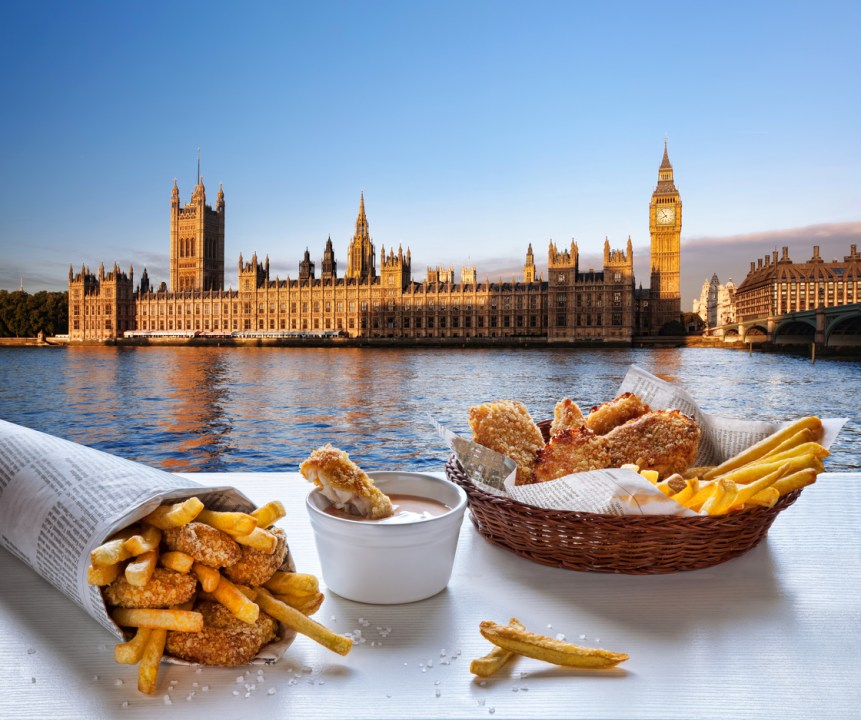Anyone who finds themselves gazing at a parliamentary samosa for two minutes or more (me, for the avoidance of doubt) probably has a problem. Sadly, this is what my life has become since the Twitter account @Parliscran arrived on the scene.
The reason the samosa was so mesmerising is because I was trying to work out whether it had been covered in balsamic glaze, a long-held obsession of mine. The sauce, dark and sticky as it appeared, was more likely to be some sort of tamarind situation, but nevertheless I found it beguiling.
A cursory doom-scroll through Parliscran would be a cathartic deviance to anybody who enjoys food. It is almost therapeutic, a little sado-masochistic, because the cuisine on display is so utterly abhorrent, so inadequate. The Palaces of Westminster are where important, life-changing decisions are made, and yet much of the food produced within is reminiscent of a troubled university dorm, perhaps worse.
Served up on Twitter today is an endlessly hilarious feed of floppy gyozas, stodgy macaroni and things that are for some reason labelled ‘jambalaya’. Each dish is transfixing. Of course the account is probably trolling, too, but the food exists whether anybody gives two tosses or not.
Some – the soups, generally, and the pies – might be passable on a ferry, or a budget flight. Other dishes better resemble something from a less-than-stellar school canteen. And yes, I’m well aware that there are restaurants in Westminster that put out more considered, coherent dishes. These are the places high-fliers, MPs and the like are more readily found, I suppose. But I’ve eaten in the Peers’ Dining Room, allegedly serving some of the best cuisine in the Palace, and sampled dishes elsewhere on one or two other occasions, and will testify that the food is generally poor even if it looks decent.
I actually find it quite upsetting that all those working in parliament have to put up with such terrible cuisine. The lack of effort is telling, and is perhaps suggestive of a wider issue at play: the powerful have for too long dismissed food as a secondary issue. Hospitality is a service industry to them, not a profession – made glaringly apparent at the refusal to create a hospitality minister during the pandemic, despite just cause.
Education, health and culture are all paraded continuously as necessary points of discourse. Fine. But still, hospitality is batted away. Because pubs and restaurants are places of fun, chaos and delirium, they aren’t treated with the same respect as all the issue subjects at hand. Politicians pose with pints as a quick photo op, or congregate in a branch of Nando’s to show they like dining out in voter-favourite establishments. Never mind that hospitality is the country’s third largest employer, contributing billions to the economy every year.
When a car manufacturer with, say, 2,000 staff goes bust, all hell breaks loose and political panic ensues. When a chain of 20 restaurants crumbles, with about the same number of workers, less care is afforded said company or said workers. This might be because it isn’t as tangible in that the business is made up of multiple cogs, but it should bear the same weight nonetheless.
And this is lack of care is evident in so much of the food dished out in Westminster, where in flimsy receptacles ‘jerk pork’ resembles hot sick, and stir-fried noodles look to be nothing more than a congealed hair transplant.
I do not understand why food is still deemed nothing more than fuel to so many. It doesn’t need to be front and centre, nor should it command too much time from those who have maths to do and policies to produce. But food is also unifying and necessary, and if such little regard is given to what is cooked in Westminster, you have to wonder what else is being neglected.







Comments